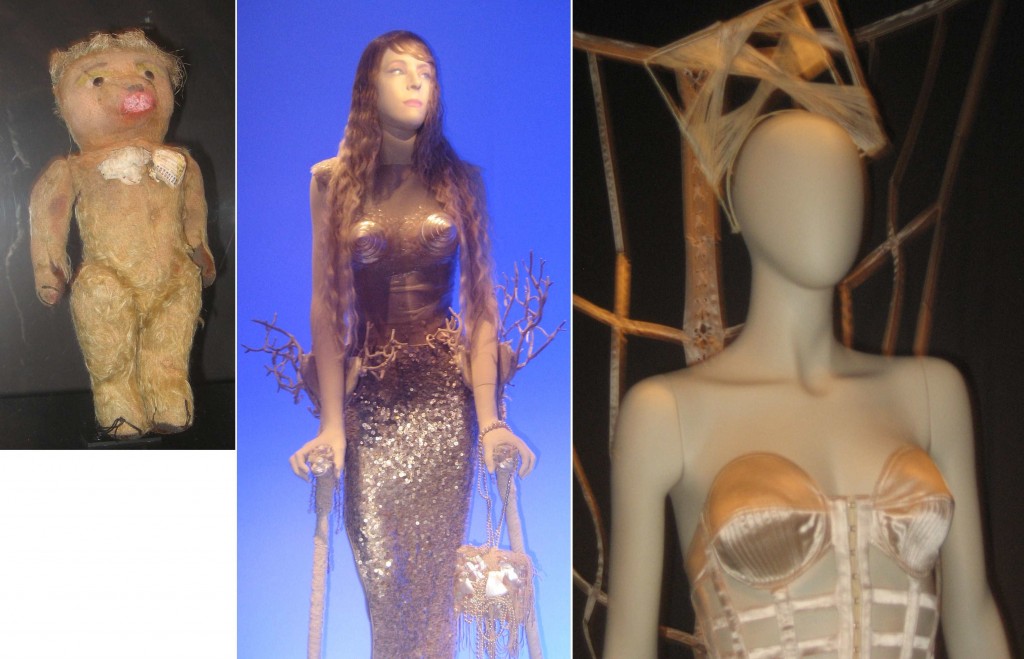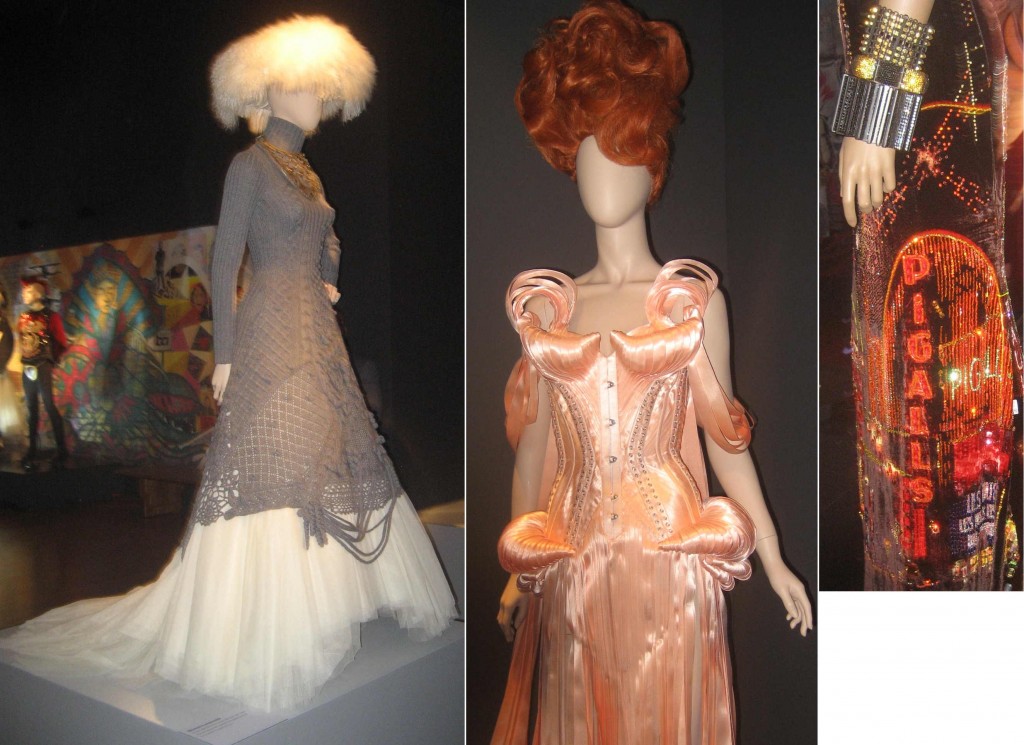 San Francisco welcomed Jean-Paul Gaultier with open arms for the arrival of The Fashion World of Jean Paul Gaultier: From the Sidewalk to the Catwalk, an exhibit originally created at the Musée des beaux-arts de Montréal (MBAM) in 2011 by Nathalie Bondil. The collection, which has already been shown in Dallas, will be at the deYoung Museum in San Francisco until August 19, then in Madrid from September to November 2012, and in Rotterdam from February to May 2013. Go catch it if you can!
San Francisco welcomed Jean-Paul Gaultier with open arms for the arrival of The Fashion World of Jean Paul Gaultier: From the Sidewalk to the Catwalk, an exhibit originally created at the Musée des beaux-arts de Montréal (MBAM) in 2011 by Nathalie Bondil. The collection, which has already been shown in Dallas, will be at the deYoung Museum in San Francisco until August 19, then in Madrid from September to November 2012, and in Rotterdam from February to May 2013. Go catch it if you can!
An installation rather than a retrospective
The exhibit isn’t merely a retrospective, but rather an art installation of Gaultier’s world. His works, put together by UBU, the Quebecois theater company run by Denis Marleau, combines multimedia animation organized by theme and realistic mannequins with the ability to speak.
The exhibit has a certain timeless quality, and what emerges is the coherence in Jean-Paul Gaultier’s design aesthetic. Certain influences – from world events to street trends – give an individual character to each collection, which fashion journalists invariably pick out season after season. However, within the context of this collection, which is thematic rather than chronological, Gaultier’s extraordinarily unified tone, spirit, and inspiration become eminently clear. This is ultimately what makes a great artist, or a great couturier, able to mix ideas and genres without losing focus. “What we see of an object placed before us, what we hear of sentence spoken in our ear, is very little indeed, next to what our memory adds to it,” said Henri Bergson. The accordionist Yvette Horner has little in common with Madonna, and yet both of them coexist, reincarnated in this exhibit, along with Naomi Campbell and many others standing in front of the Michou cabaret, rue des Martyrs in Paris, in the imaginary world of Gaultier.
Teddy bears, mermaids, and Madonnas
A creative imagination always starts somewhere. For Jean-Paul Gaultier, it’s in his childhood with his grandmother, who had gone back to work after her husband’s smock enterprise had failed. She began a skin care business that offered as much sentimental advice as it did creams and face masks. The young Jean-Paul was always hanging around; at the beginning of the eighties he once told me that “it was fabulous and, truth be told, an odd sort of education.” His grandmother succumbed to all his moods, allowed him to play with his Régécolor [a brand of coloring shampoo that had been created by l’Oréal], let him watch anything he wanted on television, including fare normally forbidden to children like the piece on the Folies-Bergère that fascinated and enthralled him at the age of nine.
The only thing that Jean-Paul could not have was a doll of his own: “My grandmother would show me her dolls from the turn of the century, which, naturally, I found extraordinary. Because I wasn’t allowed to have a doll – my mother would have thrown a fit – I got a Teddy bear that I ended up turning into a doll,” and to which he added his now iconic conical breasts. One of the first objects of the exhibit is this bear. The breasts became conjoined to his grandmother’s salmon-colored corset, and together they rise to the corset dress Jean-Paul created 1983, adapted over multiple iterations through the years.

Travels of a sailor
 Like his perfume line’s tin cans, and many other objects in the Gaultier imagination, the striped sailor shirt is “ready made” our “found art” in the style of Marcel Duchamp: that is, “an everyday object promoted to art object simply by the decision of the artist,” as André Breton defined in his Dictionnaire abrégé du surréalisme. Jean-Paul is himself a sailor in his craft, an adventurer to far-flung places whose relative distance is always measured from the meridian line of his memory, in Arcueil and Paris. By his hand, the hard waves of the open sea are tempered when they become the veins in the marble of chapels and saintly statuaries, and the gaze of Madonna melds into that of the seductive Micheline from Jacques Becker’s film Falbalas. The designer always returns to his beginnings: Spanish ladies as represented by Bizet; Russian elegance as exemplified by Elisabeth de Riquet of Caraman, Countess Greffulhe; and laces and bustles from Yvonne, who had worked in Paquin’s atelier before becoming the housekeeper for Jean-Paul’s grandmother.
Like his perfume line’s tin cans, and many other objects in the Gaultier imagination, the striped sailor shirt is “ready made” our “found art” in the style of Marcel Duchamp: that is, “an everyday object promoted to art object simply by the decision of the artist,” as André Breton defined in his Dictionnaire abrégé du surréalisme. Jean-Paul is himself a sailor in his craft, an adventurer to far-flung places whose relative distance is always measured from the meridian line of his memory, in Arcueil and Paris. By his hand, the hard waves of the open sea are tempered when they become the veins in the marble of chapels and saintly statuaries, and the gaze of Madonna melds into that of the seductive Micheline from Jacques Becker’s film Falbalas. The designer always returns to his beginnings: Spanish ladies as represented by Bizet; Russian elegance as exemplified by Elisabeth de Riquet of Caraman, Countess Greffulhe; and laces and bustles from Yvonne, who had worked in Paquin’s atelier before becoming the housekeeper for Jean-Paul’s grandmother.

For Jean-Paul, fashion is not second nature. It is the amalgam of everything he has ever loved, a land of marvels focused in Paris, where he has chosen to settle indefinitely and from which to the rest of the world can reverberate.
The exhibit’s catalogue, created by Thierry-Maxime Loriot, explores this giant of fashion and showmanship. It’s a beautiful book, published in French by the Editions de la Martinière and in English by Abrams Books.
Thank you to my daughter Sophie Delphis for translating this post originally published in French for Atlantico.fr. Special thanks to Jelka Music and Wendy Norris

0 responses so far ↓
There are no comments yet...Kick things off by filling out the form below.
Leave a Comment